.

8.07.2015
New Horizons Map of Pluto: The Whale and the Donut
This is the latest map of Pluto created from images taken from June 27 to July 3 by the Long Range Reconnaissance Imager (LORRI) on New Horizons, combined with lower-resolution color data from the spacecraft’s Ralph instrument. The center of the map corresponds to the side of Pluto that will be seen close-up during New Horizons’ July 14 flyby.
This map gives mission scientists an important tool to decipher the complex and intriguing pattern of bright and dark markings on Pluto’s surface. Features from all sides of Pluto can now be seen at a glance and from a consistent perspective, making it much easier to compare their shapes and sizes.
The elongated dark area informally known as "the whale," along the equator on the left side of the map, is one of the darkest regions visible to New Horizons. It measures some 1,860 miles (3,000 kilometers) in length.
Directly to the right of the whale’s "snout" is the brightest region visible on the planet, which is roughly 990 miles (1,600 kilometers) across. This may be a region where relatively fresh deposits of frost—perhaps including frozen methane, nitrogen and/or carbon monoxide—form a bright coating.
Continuing to the right, along the equator, we see the four mysterious dark spots that have so intrigued the world, each of which is hundreds of miles across. Meanwhile, the whale’s "tail," at the left end of the dark feature, cradles a bright donut-shaped feature about 200 miles (350 kilometers) across. At first glance it resembles circular features seen elsewhere in the solar system, from impact craters to volcanoes. But scientists are holding off on making any interpretation of this and other features on Pluto until more detailed images are in hand.
Of course, higher-resolution images in the days to come will allow mission scientists to make more accurate maps, but this map is a tantalizing preview.
"We’re at the 'man in the moon’ stage of viewing Pluto," said John Spencer of the Southwest Research Institute, Boulder, Colorado, deputy leader of the Geology, Geophysics and Imaging team. "It’s easy to imagine you’re seeing familiar shapes in this bizarre collection of light and dark features. However, it’s too early to know what these features really are."
.
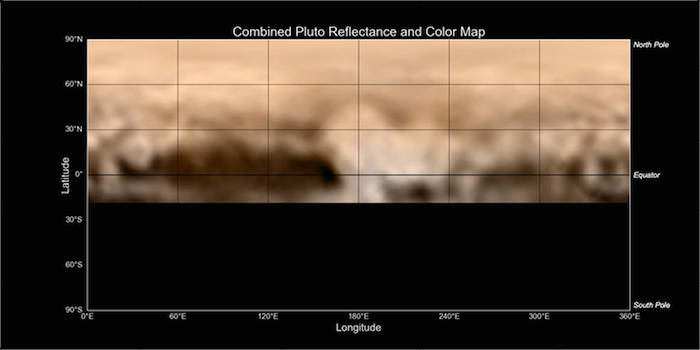
The Whale and the Donut
This map of Pluto, created from images taken from June 27-July 3, 2015, by the Long Range Reconnaissance Imager (LORRI) on New Horizons, was combined with lower-resolution color data from the spacecraft's Ralph instrument. The center of the map corresponds to the side of Pluto that will be seen close-up during New Horizons' July 14 flyby.
This map gives mission scientists an important tool to decipher the complex and intriguing pattern of bright and dark markings on Pluto's surface. Features from all sides of Pluto can now be seen at a glance and from a consistent perspective, making it much easier to compare their shapes and sizes.
The elongated dark area informally known as "the whale," along the equator on the left side of the map, is one of the darkest regions visible to New Horizons. It measures some 1,860 miles (3,000 kilometers) in length. Directly to the right of the whale’s "snout" is the brightest region visible on the planet, which is roughly 990 miles (1,600 kilometers) across. This may be a region where relatively fresh deposits of frost—perhaps including frozen methane, nitrogen and/or carbon monoxide—form a bright coating.
Credit: NASA/Johns Hopkins University Applied Physics Laboratory/Southwest Research Institute
Quelle: NASA
.
Update: 9.07.2015
.
Pluto's 'Heart' Spied by New Horizons Spacecraft (Photo)
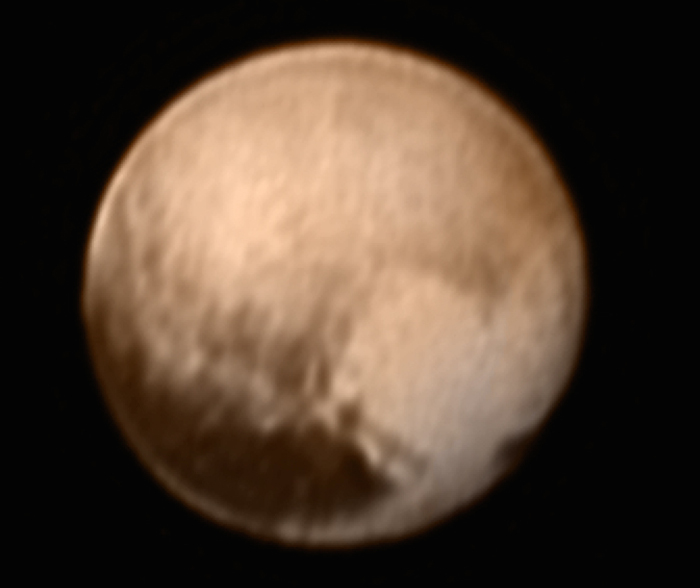
New Horizons captured this image of Pluto on July 7, 2015, when the probe was just less than 5 million miles (8 million kilometers) from the dwarf planet.
Credit: NASA-JHUAPL-SWR
.
Pluto looks especially welcoming in a new photo by NASA's approaching New Horizons probe.
The image, which New Horizons took yesterday (July 7) when it was less than 5 million miles (8 million kilometers) from Pluto, shows a large, heart-shaped feature on the dwarf planet's surface.
The bright "heart" is about 1,200 miles (2,000 km) wide, NASA officials said. To its left lies an 1,860-mile-long (3,000 km) dark patch along Pluto's equator that mission scientists are calling "the whale."
New Horizons should get much better looks at both of these intriguing features in the coming days — especially during its July 14 flyby, when the probe will zoom within 7,800 miles (12,500 km) of Pluto's surface.
"The next time we see this part of Pluto at closest approach, a portion of this region will be imaged at about 500 times better resolution than we see today," Jeff Moore, New Horizons' geology, geophysics and imaging team leader, said in a statement. "It will be incredible!" added Moore, who's based at NASA's Ames Research Center in Mountain View, California.
The New Horizons team received the new photo early this morning (July 8). (It takes about 4.5 hours for data and communications to travel from the spacecraft to Earth, since the two are separated by about 3 billion miles, or 4.8 billion km.)
The image is the first one to come back down to Earth since Saturday (July 4), when New Horizons suffered a glitch that briefly sent it into safe mode, NASA officials said. The spacecraft is now back up to speed, and has in fact begun its close-approach science operations — a choreographed sequence of observations that lasts nine days.
.

This map of Pluto, made from images taken by New Horizons from June 27 through July 3, shows a diverse array of bright and dark markings, including “the whale,” the large, elongated dark patch at bottom left.
.
"The whale" also features in New Horizons' latest color map of Pluto, which is based on photos New Horizons took from June 27 to July 3. The map reveals a bright, 200-mile-wide (320 km) ring-shaped feature lying just above the whale's tail.
The doughnutlike feature resembles impact craters and volcanoes seen on other solar system bodies, but mission scientists will wait for more detailed images before they begin a serious attempt at interpretation, NASA officials said.
Quelle: SC
-
Update: 10.07.2015
-
New Horizons' Latest Views Hint at More Mysteries on Pluto and Charon
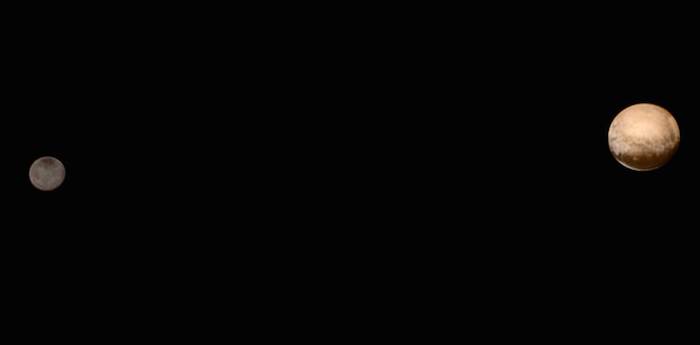
A photo from New Horizons' Long Range Reconnaissance Imager shows Pluto at right and Charon, its biggest moon, at left. The picture has been colorized using lower-resolution color imagery from the spacecraft's Ralph instrument. NASA / JHUAPL / SwRI
.
The latest and greatest views from NASA's New Horizons probe reveal what could be dimpled terrain on dwarf planet Pluto — and bright craters on Charon, its biggest moon.
The new imagery was captured Wednesday from a distance of about 3.7 million miles (6 million kilometers). It shows Pluto's heart-shaped bright area passing out of view on the right edge of its disk, a dark equatorial streak known as "the whale" stretching across the bottom, and a mysterious sliver of light material peeking from beneath the whale.
This picture also shows subtle surface variations above the whale — variations that suggest the dimpled "cantaloupe terrain" of Neptune's largest moon, Triton. Scientists say Triton could have been a world from Pluto's cosmic neighborhood that was snared by Neptune's gravitational field as it was passing by. Sharper images should reveal whether there's truly a family resemblance.
Meanwhile, New Horizons' view of Charon continues to show a dark circular area at one of its poles — plus bright areas that may be impact craters. That's a welcome sight for geologists.
"It will help us see what's hidden beneath the surface," Jeff Moore of NASA's Ames Research Center, leader of the mission's geology, geophysics and imaging team, said Thursday in a news release. "Large craters can excavate material from several miles down and reveal the composition of the interior."
The color imagery shows that Pluto's surface has a reddish cast, due to the presence of organic compounds known as tholins, while Charon is a wan gray color because it's covered with frozen water and ammonia compounds.
These two objects have been together for billions of years, in the same orbit, but they are totally different," said the mission's principal investigator, Alan Stern of the Southwest Research Institute.
Every hour brings New Horizons another 30,000 miles (50,000 kilometers) nearer to next Tuesday's flyby.
Quelle: NBC-News
-
Update:
.
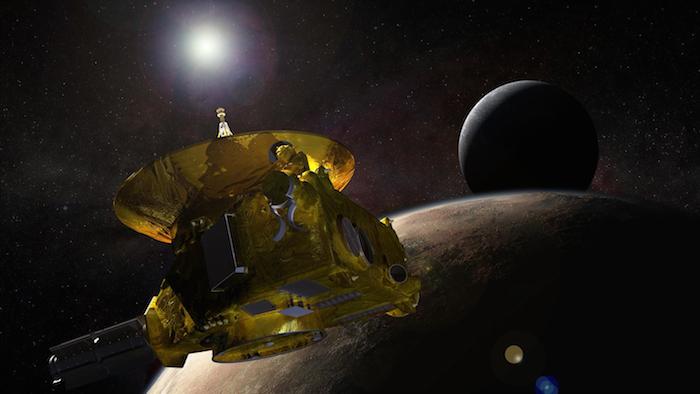
DLR fördert deutsche Wissenschaftler beim Radioexperiment REX
Nach einer neuneinhalb Jahre langen Reise wird die NASA-Raumsonde New Horizons am 14. Juli 2015 um 13.50 Uhr Mitteleuropäischer Sommerzeit und etwa 4,8 Milliarden Kilometer von der Erde entfernt am Zwergplaneten Pluto vorbeifliegen. Es ist das erste Mal, dass der ehemals "neunte Planet" des Sonnensystems Besuch bekommt und aus der "Nähe" - sprich aus rund 12.500 Kilometern Distanz, das ist weniger als ein Erddurchmesser - erforscht werden kann.
Während der Vorbeiflugphase werden sieben wissenschaftliche Experimente Fotos, Spektren und physikalische Messwerte aufzeichnen: Neben drei optischen Geräten - dem UV-Spektrometer Alice sowie den hochauflösenden Kamerasystemen LORRI und Ralph -, befinden sich zwei Plasma-Instrumente (PEPSSI und SWAP), ein Staubdetektor (Venetia) und ein Radioexperiment (REX) an Bord. REX wird mit Radiowellen die Atmosphären sondieren, die Oberflächentemperaturen und die Einzelmassen von Pluto und Charon bestimmen. Es ist das einzige Instrument auf New Horizons, an dem mit den Planetenforschern des Rheinischen Instituts für Umweltforschung an der Universität zu Köln deutsche Wissenschaftler beteiligt sind.
Das Raumfahrtmanagement des Deutschen Zentrums für Luft- und Raumfahrt (DLR) hat die Beteiligung von Dr. Martin Pätzold an dem REX-Experiment mit Mitteln des Bundesministeriums für Wirtschaft und Energie gefördert. "Als so genannter Co-Investigator führen wir zwei Experimente während des Vorbeiflugs von New Horizons an Pluto durch", berichtet Pätzold, der die heiße Phase der Mission am Applied Physics Laboratory (APL) der Johns-Hopkins-Universität in Laurel (Maryland) in den USA erlebt, das die Mission für die NASA durchführt und steuert. "Wir messen Oberflächentemperaturen von Pluto und seinem Mond Charon im Mikrowellenbereich. Und wir wollen die individuellen Massen und Dichten von Pluto und Charon direkt bestimmen. Masse und Dichte geben wichtige Hinweise auf den inneren Aufbau von planetaren Körpern und ihre Entstehung", so Pätzold weiter.
Mit REX wird auch erstmals ein Experiment durchgeführt, bei dem Radiosignale von der Erde zur Raumsonde gesendet werden - üblicherweise werden Signale analysiert, die von einer Sonde zur Erde gefunkt wurden. Dieses Mal soll eine Ablenkung und Schwächung der Signale, die von der Erde durch eine möglicherweise dünne Atmosphäre von Pluto und Charon beeinflusst und dann von REX aufgezeichnet werden, Aufschluss über Temperatur und Druck der Atmosphäre in der Nähe der Oberflächen geben.
Eisige Körper, Milliarden Kilometer von der Sonne entfernt
"Der etwa 2310 Kilometer große Pluto sowie sein naher und etwas kleinerer Begleiter Charon stellen für die Planetenforschung eine noch fast unbekannte Welt dar. Aus diesem Grund werden die Bilder und Messungen von New Horizons von Wissenschaftlern auf der ganzen Welt mit Spannung erwartet", verdeutlicht Prof. Tilman Spohn, Direktor des DLR-Instituts für Planetenforschung in Berlin.
Mit den Fotos erhoffen sich die Wissenschaftler, die Geologie von Pluto und Charon sowie die zugrunde liegenden Prozesse zu verstehen. Außerdem werden die Bestandteile der Oberfläche geochemisch und mineralogisch analysiert und die hauchdünne Atmosphäre aus verdampfenden Eisverbindungen untersucht. Aus geophysikalischen Messungen soll der innere Aufbau des Doppelkörpersystems Pluto-Charon entschlüsselt werden.
"Dies macht Pluto sogar zu einem Objekt für die Suche nach ökologischen Nischen, in denen die Entwicklung von einfachen Lebensformen vorstellbar wäre", sagt DLR-Planetenforscher Spohn, und ergänzt: "Pluto ist das größte bekannte Objekt des so genannten Kuiper-Edgeworth-Gürtels, einer Zone von eisigen Körpern jenseits der Bahn des Neptun in fünf bis zehn Milliarden Kilometern Entfernung zur Sonne. Ähnlich den Asteroiden und Kometen sind diese 'Eiszwerge' seit ihrer Entstehung vermutlich kaum durch geologische Prozesse verändert worden. Wie der Komet 67P 'Tschuri', den wir im Moment mit der Sonde Rosetta untersuchen, könnte uns Pluto also viel über die früheste Zeit des Sonnensystems verraten!"
Ein Einschwenken in eine Umlaufbahn ist allerdings wegen der extrem hohen Geschwindigkeit von rund 50.000 Stundenkilometern, mit der sich New Horizons Pluto nähert, technisch nicht möglich.
Das APL geht davon aus, dass die ersten Bilder von Pluto und Charon aus nächster Nähe am 15. Juli 2015 zur Verfügung stehen. Wegen der langen Signallaufzeit im Funkverkehr mit der Sonde von fast viereinhalb Stunden für die einfache Wegstrecke wird es aber noch über ein Jahr dauern, ehe alle wissenschaftlichen Aufzeichnungen aus dem Bordcomputer zur Erde übertragen sind.
Die schnellste Raumsonde, die je unterwegs war
New Horizons startete am 19. Januar 2006 von Cape Canaveral (Florida). Am 28. Februar 2007 wurde die knapp 500 Kilogramm schwere Sonde durch einen Nahvorbeiflug am Jupiter auf ihre endgültige Reisegeschwindigkeit beschleunigt: Danach entfernte sie sich mit 83.600 Kilometern von der Sonne. Der Vorbeiflug an Pluto und Charon wird mit einer relativen Geschwindigkeit von 50.400 Stundenkilometern erfolgen - damit ist New Horizons die schnellste Raumsonde, die je im Sonnensystem unterwegs war. Pluto ist von der Erde wie die ebenfalls weit entfernten Planeten Uranus und Neptun mit dem bloßen Auge nicht zu sehen. Die Internationale Astronomische Union ordnete 2006 das Planetensystem neu und stufte Pluto als Zwergplanet ein, hauptsächlich wegen des Arguments, dass sich auf seiner Bahn möglicherweise noch weitere Körper befinden, die Pluto mit seiner Schwerkraft noch nicht "aus dem Weg" geräumt hat, wie es bei den anderen acht "klassischen" Planeten der Fall ist. Bereits im Januar 2015 hat New Horizons mit den Beobachtungen von Pluto und Charon begonnen. Der Zwergplanet hat insgesamt fünf Monde - von dem gesamten Pluto-System gibt es bislang allerdings nur wenige aussagekräftige Teleskopbeobachtungen und einige Bilder des Hubble-Weltraumteleskops.
Quelle: DLR
-
Update: 11.07.2015
-
New Image of Pluto: 'Houston, We Have Geology'
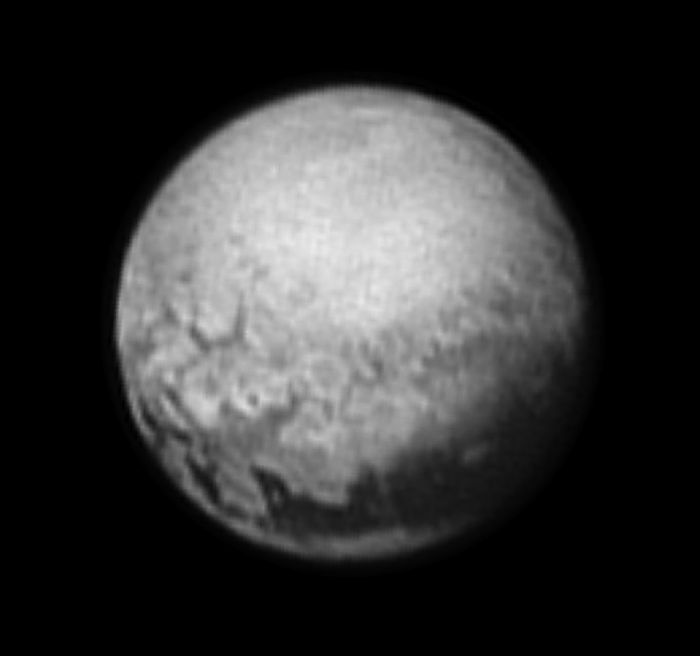
Tantalizing signs of geology on Pluto are revealed in this image from New Horizons taken on July 9, 2015 from 3.3 million miles (5.4 million kilometers) away.
.
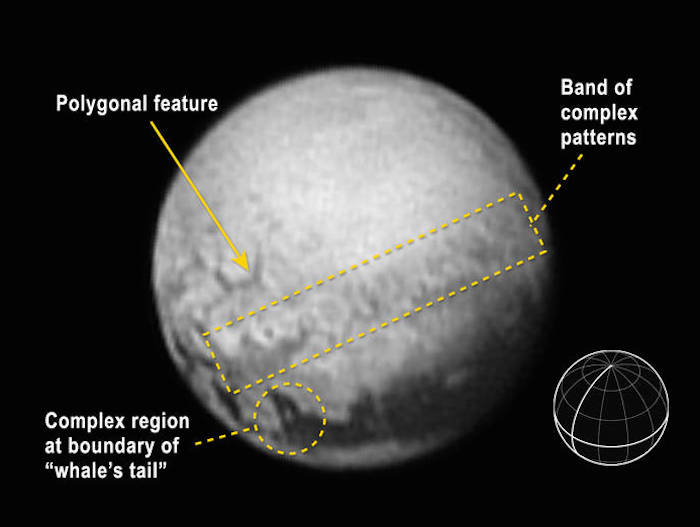
An annotated version indicates features described in the text, and includes a reference globe showing Pluto’s orientation in the image, with the equator and central meridian in bold.
.
It began as a point of light. Then, it evolved into a fuzzy orb. Now – in its latest portrait from NASA’s New Horizons spacecraft – Pluto is being revealed as an intriguing new world with distinct surface features, including an immense dark band known as the “whale.”
As the newest black and white image from New Horizons’ Long Range Reconnaissance Imager (LORRI) appeared on the morning of July 10, members of the science team reacted with joy and delight, seeing Pluto as never before. There will no doubt be many similar moments to come. New images and data are being gathered each day as New Horizons speeds closer to a July 14 flyby of Pluto, following a journey of three billion miles.
“We’re close enough now that we’re just starting to see Pluto’s geology,” said New Horizons program scientist Curt Niebur, NASA Headquarters in Washington, who’s keenly interested in the gray area just above the whale’s “tail” feature. “It’s a unique transition region with a lot of dynamic processes interacting, which makes it of particular scientific interest.”
New Horizons’ latest image of Pluto was taken on July 9, 2015 from 3.3 million miles (5.4 million kilometers) away, with a resolution of 17 miles (27 kilometers) per pixel. At this range, Pluto is beginning to reveal the first signs of discrete geologic features. This image views the side of Pluto that always faces its largest moon, Charon, and includes the so-called “tail” of the dark whale-shaped feature along its equator. (The immense, bright feature shaped like a heart had rotated from view when this image was captured.)
“Among the structures tentatively identified in this new image are what appear to be polygonal features; a complex band of terrain stretching east-northeast across the planet, approximately 1,000 miles long; and a complex region where bright terrains meet the dark terrains of the whale,” said New Horizons principal investigator Alan Stern. “After nine and a half years in flight, Pluto is well worth the wait.”
.

Science team members react to the latest image of Pluto at the Johns Hopkins University Applied Physics Lab on July 10, 2015. Left to right: Cathy Olkin, Jason Cook, Alan Stern, Will Grundy, Casey Lisse, and Carly Howett.
Credits: Michael Soluri
Quelle: NASA-
Update: 12.07.2015
.
New Horizons’ Last Portrait of Pluto’s Puzzling Spots
-
New Horizons' last look at Pluto's Charon-facing hemisphere reveals intriguing geologic details that are of keen interest to mission scientists. This image, taken early the morning of July 11, 2015, shows newly-resolved linear features above the equatorial region that intersect, suggestive of polygonal shapes. This image was captured when the spacecraft was 2.5 million miles (4 million kilometers) from Pluto.
Credit: NASA/Johns Hopkins University Applied Physics Laboratory/Southwest Research Institute
.
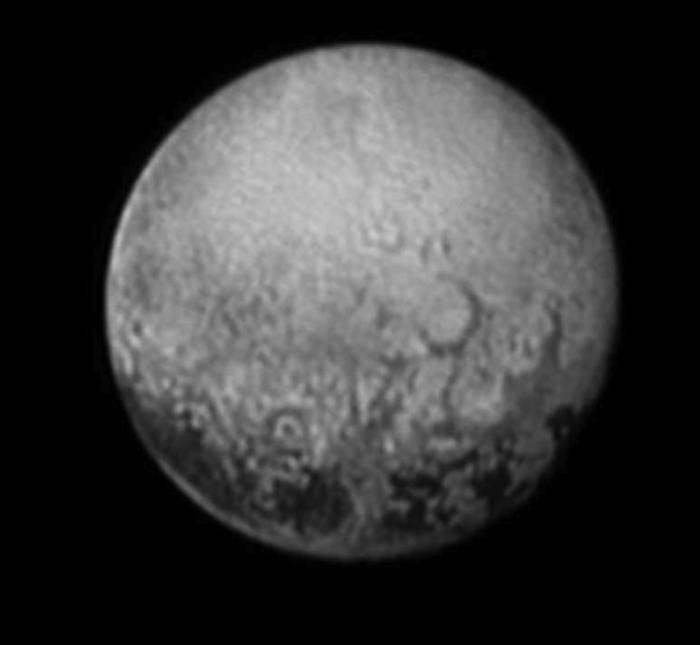
Three billion miles from Earth and just two and a half million miles from Pluto, NASA’s New Horizons spacecraft has taken its best image of four dark spots that continue to captivate.
The spots appear on the side of Pluto that always faces its largest moon, Charon—the face that will be invisible to New Horizons when the spacecraft makes its close flyby the morning of July 14. New Horizons principal investigator Alan Stern of the Southwest Research Institute, Boulder, Colorado, describes this image as “the last, best look that anyone will have of Pluto’s far side for decades to come.”
The spots are connected to a dark belt that circles Pluto’s equatorial region. What continues to pique the interest of scientists is their similar size and even spacing. “It’s weird that they’re spaced so regularly,” says New Horizons program scientist Curt Niebur at NASA Headquarters in Washington. Jeff Moore of NASA’s Ames Research Center, Mountain View, California, is equally intrigued. “We can’t tell whether they’re plateaus or plains, or whether they’re brightness variations on a completely smooth surface.”
The large dark areas are now estimated to be 300 miles (480 kilometers) across, an area roughly the size of the state of Missouri. In comparison with earlier images, we now see that the dark areas are more complex than they initially appeared, while the boundaries between the dark and bright terrains are irregular and sharply defined.
In addition to solving the mystery of the spots, the New Horizons Geology, Geophysics and Imaging team is interested in identifying other surface features such as impact craters, formed when smaller objects struck the dwarf planet. Moore notes, “When we combine images like this of the far side with composition and color data the spacecraft has already acquired but not yet sent to Earth, we expect to be able to read the history of this face of Pluto.”
When New Horizons makes its closest approach to Pluto in just three days, it will focus on the opposing or “encounter hemisphere” of the dwarf planet. On the morning of July 14, New Horizons will pass about 7,800 miles (12,500 kilometers) from the face with a large heart-shaped feature that’s captured the imagination of people around the world.
At 7:49 AM EDT on Tuesday, July 14 New Horizons will zip past Pluto at 30,800 miles per hour (49,600 kilometers per hour), with a suite of seven science instruments busily gathering data. The mission will complete the initial reconnaissance of the solar system with the first-ever look at the icy dwarf planet.
Quelle: NASA
-
Update: 13.07.2015 / 16.30 MESZ
.
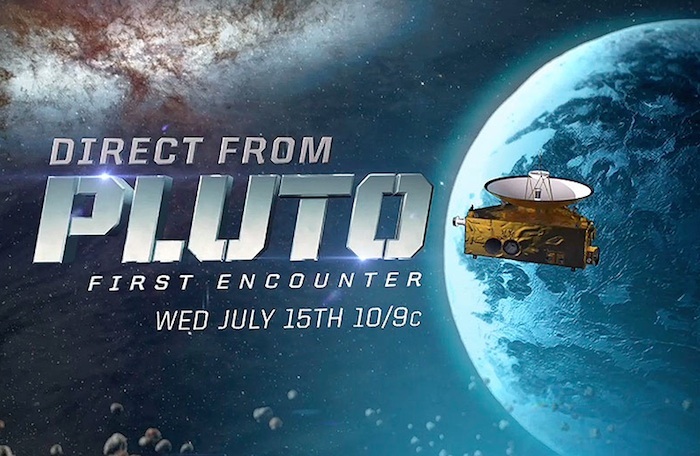

Quelle: NASA
---
Huge Canyon Spied on Pluto Moon Charon

Annotated version of the Charon image captured by NASA’s New Horizons spacecraft on July 11, 2015.
Credit: NASA/JHUAPL/SWRI
.
"New Horizons has transformed our view of this distant moon from a nearly featureless ball of ice to a world displaying all kinds of geologic activity," added McKinnon, who's based at Washington University in St. Louis.
The most noticeable crater in the new photo, which was received at mission control today (July 12), is about 60 miles (100 km) wide and lies near Charon's south pole. The brightness of the rays emanating from the crater suggests that it formed relatively recently, researchers said.
The crater's floor is significantly darker than surrounding areas, perhaps because the impact that gouged out the crater exposed different material than that found on the surface. It's also possible that material at the bottom of the crater simply has a larger grain size and therefore reflects less sunlight, mission team members said.
Charon is by far the largest of Pluto's five known moons. At about 750 miles (1,200 km) in diameter, Charon is about half as wide as the dwarf planet itself.
.

Annotated version of the Pluto photo taken by New Horizons on July 11, 2015, showing linear features that may be cliffs, as well as a large circular feature that could be an impact crater.
Credit: NASA/Johns Hopkins University Applied Physics Laboratory/Southwest Research Institute
.
New Horizons also captured Pluto in unprecedented detail Saturday. A photo taken that day by the spacecraft shows linear features that could be cliffs as well as a probable impact crater, mission team members said.
New Horizons is speeding toward the first-ever flyby of Pluto. On Tuesday morning, the spacecraft will zoom within 7,800 miles (12,500 km) of the dwarf planet, gathering a variety of data about Pluto, Charon and the system's other four satellites with its seven science instruments. Closest approach will occur at 7:49 a.m. EDT (1149 GMT).
Quelle: SC
...
Update: 22.00 MESZ
.
How Big Is Pluto? New Horizons Settles Decades-Long Debate
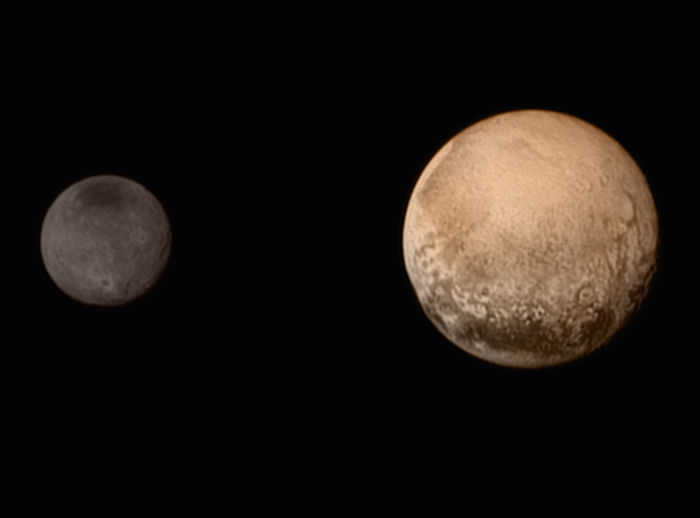
NASA’s New Horizons mission has answered one of the most basic questions about Pluto—its size.
Mission scientists have found Pluto to be 1,473 miles (2,370 kilometers) in diameter, somewhat larger than many prior estimates. Images acquired with the Long Range Reconnaissance Imager (LORRI) were used to make this determination. This result confirms what was already suspected: Pluto is larger than all other known solar system objects beyond the orbit of Neptune.
“The size of Pluto has been debated since its discovery in 1930. We are excited to finally lay this question to rest,” said mission scientist Bill McKinnon, Washington University, St. Louis.
Pluto’s newly estimated size means that its density is slightly lower than previously thought, and the fraction of ice in its interior is slightly higher. Also, the lowest layer of Pluto’s atmosphere, called the troposphere, is shallower than previously believed.
Measuring Pluto’s size has been a decades-long challenge due to complicating factors from its atmosphere. Its largest moon Charon lacks a substantial atmosphere, and its diameter was easier to determine using ground-based telescopes. New Horizons observations of Charon confirm previous estimates of 751 miles (1208 km) kilometers) across
LORRI has also zoomed in on two of Pluto’s smaller moons, Nix and Hydra.
“We knew from the time we designed our flyby that we would only be able to study the small moons in detail for just a few days before closest approach,” said New Horizons Principal Investigator Alan Stern of the Southwest Research Institute, Boulder, Colorado. “Now, deep inside Pluto’s sphere of influence, that time has come.”
Nix and Hydra were discovered using the Hubble Space Telescope in 2005. Even to Hubble, they appeared as points of light, and that’s how they looked to New Horizons until the final week of its approach to Pluto. Now, the latest LORRI images show the two diminutive satellites not as pinpoints, but as moons seen well enough to measure their sizes. Nix is estimated to be about 20 miles (about 35 kilometers) across, while Hydra is roughly 30 miles (roughly 45 kilometers) across. These sizes lead mission scientists to conclude that their surfaces are quite bright, possibly due to the presence of ice.
What about Pluto’s two smallest moons, Kerberos and Styx? Smaller and fainter than Nix and Hydra, they are harder to measure. Mission scientists should be able to determine their sizes with observations New Horizons will make during the flyby and will transmit to Earth at a later date.
.
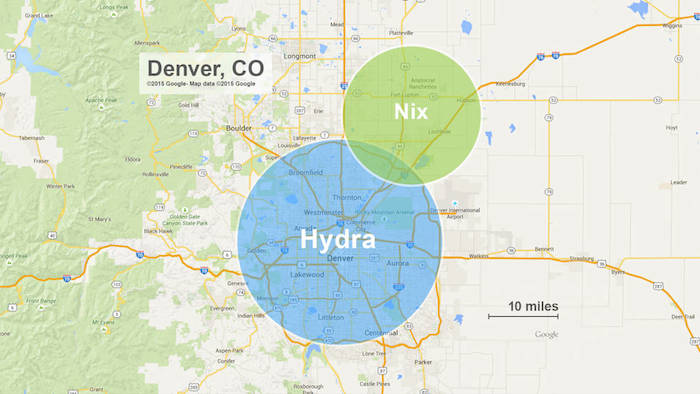
The approximate sizes of Pluto’s moons Nix and Hydra compared to Denver, Colorado. While Nix and Hydra are illustrated as circles in this diagram, mission scientists anticipate that future observations by New Horizons will show that they are irregular in shape.
Credits: JHUAPL/Google
Quelle: NASA
4837 Views
